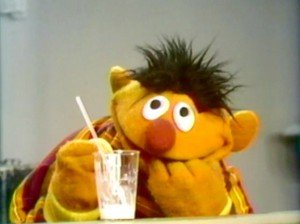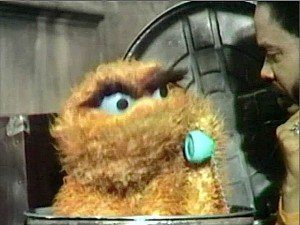Sesame Street Ep #115
The honey bear is the perfect antidote to the Gordonnness of the first 20 minutes of the show, putting me in the perfect mood for an adorable Ernie and Cookie Monster sketch. Apparently, many of Cookie Monster’s early sketches were between Ernie and him, which I hadn’t realized. Also, our blue, googly-eyed friend actually went from being a monster who would eat anything indiscriminately to specifically a cookie fiend during a sketch with Ernie.
And while I don’t know for sure, it very well could have been this one, in which Ernie puts down a glass of milk and runs to the kitchen to fetch a cookie, during which time Cookie arrives and drinks the milk (I don’t care how many times I’ve seen a Muppet suck up a glass of liquid with a straw, the illusion never gets old). Then, upon arriving back in the room, a confused Ernie returns to the kitchen to get more milk, this time leaving the cookie, which Cookie naturally grabs.
Now, we can tell this is an early sketch because later on, Cookie would’ve reduced that thing to a pile of crumbs in seconds, but here he simply takes a few bites off the end, before he runs off to hide at Ernie’s return. At this point, Ernie knows something has got to be up, so he pours a new glass of milk (which had to have been a pretty delicate job for Jim, given his arms would’ve been above his head as he performed the action), and hides to see if he can catch the culprit in the act, and lo and behold! He discovers Cookie! However, Cookie doesn’t act monstrously towards him but instead behaves very affectionately, showing sorrow at his behavior and even giving him a kiss and a pat on the head, a nice moment that reiterates for any frightened children that on Sesame Street, monsters are often more silly than scary. Finally, Ernie’s temper is gone, and he even agrees to fetch Cookie his own milk and cookies. Because Cookie has clearly played him like a fiddle. “Hurry!” Cookie calls as Ernie goes off to the kitchen.
Then, we have that Big Bird and Susan scene, which cuts to a Buddy and Jim scene, which, as per usual, I outright skipped, and then after that brief bout of boredom, we’re back for another Ernie sketch, this time with good old buddy, Bert. This one’s a quick but fun one in which the phone is ringing but is nowhere to be found, so Bert suggests Ernie look in a basket, where Ernie pulls out a variety of items and attempts to answer each one, such as a feather duster, a mallet, and finally a banana. “That’s a banana, you meatball!” Bert scolds him. “Shh!” Ernie says, and proceeds to talk into the banana, as if he’s answered the phone. “It’s for you, Bert,” he says, and just when Bert takes it and actually starts to talk into it, thinking maybe, just maybe Ernie was telling the truth, Ernie picks up the actual phone, telling the person on the other end of the line, “I’m sorry. Bert can’t come to the phone now. He’s talking on the banana.” Ba dum dum siss.
This cuts to a scene in which Orange Oscar is depressed over the fact that he has nothing to complain about (perhaps he could start with his current coloring?). Gordon tries to help him think of something, such as the bright, sunny weather, but Oscar considers complaining about the weather to be too overdone.
Finally, he decides to get out his phone and call up Dial-A-Grouch, a Grouch service which provides someone to darken up your day. The number is 987-654-321. Well played, Sesame Street! But when Oscar dials, the crabby voice on the other end of the line tells him that he actually dialed 123-456-789, which Oscar says is impossible. They proceed to fight, realize they’re both Grouches, and Oscar invites him to the next Grouch meeting. And while it’s never specifically said, I have to guess that he had reached Dial-A-Grouch after all, and the “wrong number” thing was just the annoyance that the Grouch service provided him with. Hopefully my crazy internet fan theory will catch on.
Then we have a song sung by Roosevelt Franklin about counting. Roosevelt is a character who was actually created and voiced by Matt Robinson, who played Gordon at this point, and the girl in this sketch is played by Loretta Long. Apparently, in the early years of the show, he was considered a main character, even getting his own record. He’s an unusual Muppet for, despite being purple, he is clearly coded as an African American boy, and he was apparently a source of controversy among African American intellectuals, some of whom considered him and the way he spoke too stereotypically black and others not black enough. I don’t personally have much to say about the scene other than that I was struck by the particularly Motownish sound of the music and was surprised to hear Susan and Gordon’s voices coming out of Muppet mouths.
But now we finally come to the episode’s piece de resistance, the first-ever appearance of Joe Raposo’s magnificent anthem for Kermit, “Bein’ Green,” which besides being one of his most famous songs, is arguably the moment where Kermit truly, fully became the Kermit we know today. Jim’s biographer, Brian Jay Jones called it “an anthem for tolerance and self-acceptance that seemed tailor-made as a hymn for the new decade, still struggling with the turbulent civil rights reform, political skepticism, and sputtering idealism that had marked the end of the 1960s,” and as with the best of Sesame Street, it delivers its message sincerely, without a trace of saccharine or overly obvious didacticism.
And I’d add, as far as Kermit’s character, the little guy declaring his love for himself and his color, despite how it might set him apart, is what turned him from the sometimes-self-deprecating, often wisecracking “I’m just a frog” character he was before to the kinder, gentler, voice-of-reason character we now know and love. I wouldn’t go so far as to say it gave Kermit his heart, because he already had it, but it brought it out in a way that hadn’t been seen before it, also setting the stage for Kermit’s romantic dreamer side, as exemplified in The Muppet Movie and “Rainbow Connection”.



